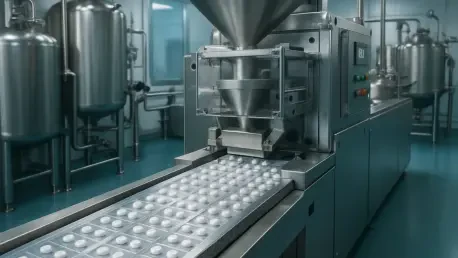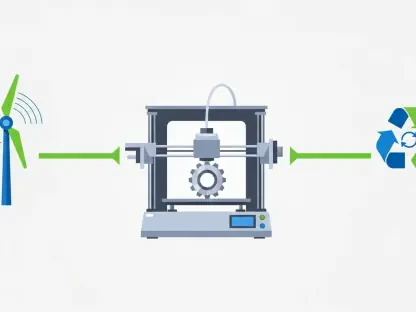The U.S. pharmaceutical sector finds itself at a critical juncture with the rollout of President Donald J. Trump’s SAPIR (Strategic Active Pharmaceutical Ingredients Reserve) Initiative, a groundbreaking policy introduced via an Executive Order on August 13 of this year. This ambitious plan seeks to fundamentally alter the landscape of drug manufacturing by prioritizing domestic production over foreign reliance, addressing a vulnerability that has long plagued the nation’s supply chain. With a mere 10% of Active Pharmaceutical Ingredients (APIs) currently made on American soil, the risks posed by geopolitical instability, natural disasters, and other disruptions have escalated into a pressing national security issue. The SAPIR Initiative represents more than just a policy adjustment; it’s a strategic imperative aimed at fostering resilience and self-sufficiency in an industry critical to public health. By reshaping how and where essential drugs are produced, this initiative signals a seismic shift that could redefine pharmaceutical manufacturing for decades to come.
Driving Domestic Production Through Policy
The core of the SAPIR Initiative lies in its mandate to stockpile APIs for 26 critical drugs and maintain a six-month supply of 86 essential medicines, with a clear directive to source these materials domestically. Administered by the Office of the Assistant Secretary for Preparedness and Response (ASPR), federal contracts are being channeled to U.S.-based manufacturers to fortify the supply chain against potential crises. This policy isn’t merely about preparation; it’s a deliberate effort to reduce dependency on foreign sources that could falter under international tensions or unexpected disruptions. By establishing a robust reserve of critical drug components, the government aims to ensure that access to life-saving medications remains uninterrupted, even in the face of global uncertainties. This move underscores a broader recognition that pharmaceutical security is integral to national stability, positioning domestic production as a non-negotiable priority in safeguarding public health.
Beyond stockpiling, the initiative integrates a suite of supportive measures to incentivize American manufacturing, signaling a long-term commitment to industry transformation. The focus on federal contracts provides a financial lifeline to domestic producers, creating a stable demand for locally made APIs and Key Starting Materials (KSMs). Additionally, regulatory frameworks are being adjusted to ease the transition, ensuring that companies face fewer bureaucratic hurdles when setting up or expanding U.S. facilities. This comprehensive approach addresses not only immediate vulnerabilities but also the structural weaknesses that have left the nation exposed for too long. As these policies take root, they are expected to catalyze a wave of reinvestment in American manufacturing capabilities, potentially reversing decades of outsourcing trends. The emphasis on self-reliance reflects a strategic pivot, one that could serve as a model for other critical industries facing similar supply chain challenges.
Tariffs Fueling the Reshoring Movement
A pivotal element of the SAPIR Initiative is the use of aggressive tariffs to compel pharmaceutical companies to relocate manufacturing to the U.S., with a striking 250% tariff imposed on Chinese APIs and a 25% levy on medical devices from Canada and Mexico. These measures have acted as a powerful catalyst, prompting industry leaders such as AbbVie, Johnson & Johnson, Roche, and AstraZeneca to pledge billions toward establishing or expanding facilities on American soil. Far from being a mere punitive tool, these tariffs are strategically designed to make foreign dependency financially unsustainable, pushing companies to rethink their global supply chains. The resulting shift isn’t just about avoiding costs—it’s a calculated response to mitigate operational risks tied to overseas production, ensuring greater control over quality and availability of essential drugs.
This tariff-driven reshoring movement is already yielding tangible outcomes, as major pharmaceutical players recalibrate their strategies to align with the new economic realities. The financial commitments from these corporations reflect a broader industry acknowledgment that domestic manufacturing is no longer optional but a competitive necessity in the face of mounting geopolitical pressures. Beyond individual company actions, this trend is fostering a renewed ecosystem of U.S.-based suppliers and contractors, revitalizing regions that have long struggled with industrial decline. However, the rapid pace of this transition also raises questions about capacity and readiness, as scaling up production domestically requires significant investment in infrastructure and skilled labor. Despite these challenges, the momentum created by tariffs suggests a transformative wave that could redefine the pharmaceutical manufacturing landscape for the foreseeable future.
Unlocking Investment Potential
For investors, the SAPIR Initiative presents a unique window of opportunity as the pharmaceutical sector pivots toward domestic production of APIs and related materials. Companies like AbbVie, Thermo Fisher Scientific, and Merck are emerging as key players, poised to benefit from federal contracts and supportive regulatory mechanisms such as the FDA’s PreCheck program, which accelerates approvals for new American facilities. The substantial financial commitments already made by these firms underscore the scale of potential returns for those who act early in this evolving market. By aligning with the government’s push for self-sufficiency, investors can tap into a growing demand for domestically produced drug components, supported by a policy environment designed to prioritize U.S.-based operations. This shift marks a rare alignment of national interest and private sector profitability, creating fertile ground for strategic investments.
However, navigating this landscape requires a nuanced understanding of the broader implications and market dynamics at play. The focus on domestic API producers and contract manufacturers is not just about immediate gains but also about long-term positioning in an industry undergoing structural change. Federal contracts managed by ASPR provide a degree of financial certainty, while regulatory tailwinds reduce barriers to entry for new facilities. Yet, the investment climate is also shaped by the need for innovation in manufacturing processes to meet stringent quality standards and cost efficiencies. As billions flow into domestic expansion, the ripple effects are likely to benefit ancillary sectors such as technology providers and logistics firms that support pharmaceutical production. For savvy investors, the key lies in identifying companies that not only secure government backing but also demonstrate agility in adapting to this reshaped industrial framework, ensuring sustained growth amid a rapidly changing environment.
Navigating Risks in a Dynamic Environment
While the opportunities under the SAPIR Initiative are substantial, investors must contend with a range of risks that could temper short-term gains in this transformative period. A narrowing window for action is driven by factors such as regulatory uncertainty, potential supply chain bottlenecks, and the looming possibility of policy shifts under a future administration. Scaling up domestic production is a complex endeavor that demands time, capital, and coordination, often leading to near-term volatility as companies adjust to new operational realities. Tariffs, while effective in spurring reshoring, could also disrupt existing supply chains, creating temporary shortages or cost spikes. These challenges highlight the importance of strategic timing and due diligence for those looking to capitalize on the evolving pharmaceutical market, balancing immediate hurdles against long-term potential.
Despite these uncertainties, there are reasons for cautious optimism as the push for supply chain resilience garners bipartisan support, suggesting a degree of policy continuity beyond the current political cycle. The shared recognition of the dangers posed by foreign dependency, particularly on APIs from regions with geopolitical tensions, underpins a collective resolve to prioritize domestic manufacturing. This consensus offers a stabilizing factor, mitigating some of the risks tied to political transitions. Nevertheless, investors must remain vigilant, monitoring developments in regulatory clarity and industry capacity to ensure informed decision-making. The interplay of risk and opportunity in this space underscores the need for a measured approach, focusing on companies with robust plans for domestic expansion and a clear alignment with federal priorities. As the market adapts, agility and foresight will be critical in navigating this dynamic and rapidly evolving landscape.
Envisioning a Self-Reliant Future
The SAPIR Initiative signifies more than a temporary policy adjustment; it heralds a profound structural transformation of the U.S. pharmaceutical industry toward self-reliance and independence. This shift transcends reactive measures to crises, embedding itself in a strategic vision that intertwines national security with economic pragmatism. The consensus among industry stakeholders is unequivocal: the heavy reliance on foreign APIs, particularly from China, represents an intolerable risk that must be addressed through sustained domestic investment. As major corporations realign their operations to prioritize American manufacturing, this movement is poised to create a competitive edge, ensuring greater control over drug quality and supply. The long-term implications point to a reimagined industry, one less vulnerable to external shocks and more attuned to national priorities.
Reflecting on the broader impact, this initiative sets a precedent for how policy can drive industrial renewal, offering lessons for other sectors grappling with similar supply chain vulnerabilities. The commitment to domestic production is already reshaping regional economies, revitalizing communities through job creation and infrastructure development. For stakeholders, the path forward involves not just capitalizing on immediate opportunities but also contributing to a resilient framework that can withstand future challenges. As the industry evolves, continued collaboration between government and private entities will be essential to address capacity gaps and technological needs. Looking back, the decisive actions taken through the SAPIR Initiative marked a turning point, laying the groundwork for a pharmaceutical sector that prioritized security and self-sufficiency, with lasting benefits for both the economy and public health.









